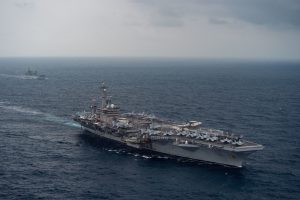U.S. Secretary of the Navy Carlos Del Toro issued his strategic guidance to the U.S. Navy and Marine Corps in October, making clear that China was the department’s top strategic priority and an organizing principle for institutional reforms, calling it “the pacing challenge against which we must plan our warfighting strategies and investments.” He warned that China was the department’s most significant long-term challenge.
According to Del Toro, the real upshot for the navy and marine corps is that “for the first time in at least a generation, we have a strategic competitor who possesses naval capabilities that rival our own, and who seeks to aggressively employ its forces to challenge U.S. principles, partnerships, and prosperity.”
The People’s Liberation Army Navy’s burgeoning capabilities in relation to the U.S. Navy were put in stark relief by the Pentagon’s annual report on Chinese military activities, released last week. Perhaps the most significant findings in the report were upgraded assessments that China may double or even triple its nuclear arsenal by the end of the decade — made on the heels of revelations this summer of major new missile silo fields under construction in the Chinese interior.
The other highlight are projections for the size of the PLAN, which, like estimates for China’s nuclear ambitions, appear revised significantly up over the Pentagon’s 2020 report.
Last year’s report emphasized that China’s fleet was the largest in the world, with a battle force of 350 ships, compared to the U.S. Navy’s 293, but offered no estimate for how much larger the PLAN might grow, or how quickly. This year’s report lists the PLAN as having 355 battle force ships (the U.S. fleet now stands at 294 ships).
Three-hundred and fifty-five ships is a politically significant number in the United States — it was the goal set by the U.S. Navy for its own fleet during the Trump administration. The U.S. Navy’s last fleet architecture study in 2020 set out an (unfunded) plan to reach 355 ships by 2035, amid an even more ambitious plan to build a hybrid fleet of 500 traditional and unmanned platforms by 2045.
A net increase in fleet size by five ships over a year is significant, but far more significant is the report’s assessment that the overall size of China’s fleet could reach 420 by mid-decade — an extraordinary jump — and 460 ships by 2030, still five years before the U.S. Navy hopes to reach the size the PLAN is today (again, a goal that itself has not been fully funded by the U.S. Congress).
While the U.S. Navy has fewer ships, those ships still possess a qualitative edge over most of their Chinese counterparts: The U.S. maintains 10 carrier strike groups (soon to be 11) against China’s two far less capable groups, one of which is still principally used for training purposes; and the U.S. fleet still has nearly three times the number of advanced major surface combatants (destroyers and cruisers) as China.
But in sufficient numbers, even less-capable platforms can overwhelm fewer advanced ones, and the United States’ advantage in those most advanced warships is shrinking.
The PLAN is expected to launch its fourth Type 055 destroyer in December. Although sometimes described as a destroyer, at 12,000 tons displacement, with expanded command-and-control capabilities, and more vertical missile launchers than China’s advanced Type 052C and 052D destroyers, the Type 055 is more analogous to the U.S. Navy’s Ticonderoga–class cruisers. China is expected to build 16 Type 055s, which are likely to play a crucial air defense and escort role in China’s nascent carrier strike groups.
The U.S. Navy still has 22 active cruisers, but the Type 055s are brand new, while the Ticonderogas are approaching the end of their service lives, with the first beginning to decommission in the mid-2020s. The effort to buy a replacement for the aging U.S. cruisers has been a nearly two-decade odyssey stymied by conceptual shortcomings and Congressional balking at cost estimates, all while struggling to modernize and extend the existing Ticonderogas’ service lives.
The U.S. Navy’s latest solution to the impending “cruiser gap” is to fold the necessary air defense and command functions into a next generation destroyer that will eventually replace both the Ticonderoga-class cruisers and its Arleigh Burke-class destroyers. If the U.S. Navy keeps to its projected timelines, the first new destroyer will be ready in 2032. Until then, the Type III Arleigh Burke destroyer — a larger, more capable variant of the venerable class — is expected to fill in the traditional cruiser role in American strike groups as the Ticonderogas begin to decommission more rapidly toward the end of the 2020s.
But it may be wrong to project that China’s navy will continue to grow at its current rate, let alone an accelerating rate. A significant concern among U.S. naval experts is that even if U.S. ships are broadly more capable than equivalent Chinese warships, like the Ticonderoga-class, most of them are much older, require more maintenance, and will be retired sooner than their counterparts in the Chinese fleet.
But over the next 10 to 15 years China’s shipyards may struggle to maintain the current production rate as the PLAN’s current fleet ages and accrues a maintenance burden more comparable to what the U.S. fleet has today. At that point, it is possible either that China’s naval shipbuilding will have to slow to accommodate modernizing and maintaining its older ships, or the PLAN could instead choose to retire ships facing intensive mid-life overhauls to maintain production of newer, more advanced ships. This would keep China’s fleet relatively young and capable, but also prevent it from reaching the higher ends of U.S. projections.
In either case, the PLA Navy will continue to be a numerically larger force than the U.S. Navy, and an increasingly capable one.

































